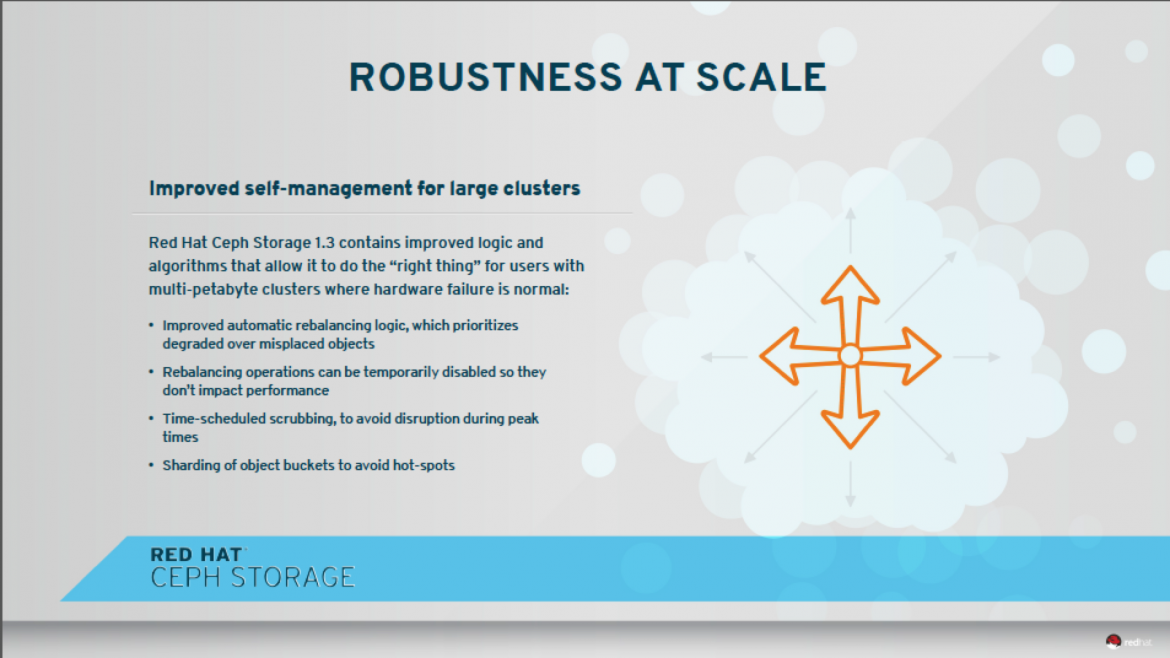Like a fine wine, Red Hat Ceph Storage (RHCS) gets better with age. During Red Hat Summit 2015, we announced the availability of RHCS 1.3, a release that brings with it improvements and tuning designed to please many an admin. Let’s take a look at what you can expect but, before we do, remember that you can test drive RHCS by visiting this link. Do it today.
Robustness at scale
Data is growing at a mind-boggling rate every year, so it makes sense that RHCS should be able to handle multi-petabyte clusters where failure is a fact of life. To mitigate that failure and enhance performance, RHCS now has:
- Improved automatic rebalancing logic that prioritizes degraded, rather than misplaced, objects
- Rebalancing operations that can be temporarily disabled so those operations don’t impede performance
- Scrubbing that can be scheduled to avoid disruption at peak times
- Object buckets that can be sharded to avoid hot-spots
Performance tuning
RHCS has been tweaked and tuned to improve speed and increase I/O consistency. This includes optimizations for flash storage devices; read-ahead caching, which accelerates virtual machine booting in OpenStack; allocation hinting, which reduces XFS fragmentation to minimize performance degradation over time; and cache hinting, which preserves the cache’s advantages and improves performance.
Operational efficiency
New features in RHCS 1.3 help admins manage storage more efficiently. For example, Calamari, the product’s management platform, now supports multiple users and clusters. Civetweb server greatly simplifies deployment of Ceph Object Gateway: it now takes only two commands to fully install RGW. CRUSH management via Calamari API allows programmatic adjustment of placement policies, and faster block device operations make resize, delete, and flatten operations quicker.
Your next step
See the changes in RHCS yourself! Visit today or hit us up on Twitter today!
About the author
Browse by channel
Automation
The latest on IT automation that spans tech, teams, and environments
Artificial intelligence
Explore the platforms and partners building a faster path for AI
Open hybrid cloud
Explore how we build a more flexible future with hybrid cloud
Security
Explore how we reduce risks across environments and technologies
Edge computing
Updates on the solutions that simplify infrastructure at the edge
Infrastructure
Stay up to date on the world’s leading enterprise Linux platform
Applications
The latest on our solutions to the toughest application challenges
Original shows
Entertaining stories from the makers and leaders in enterprise tech
Products
- Red Hat Enterprise Linux
- Red Hat OpenShift
- Red Hat Ansible Automation Platform
- Cloud services
- See all products
Tools
- Training and certification
- My account
- Developer resources
- Customer support
- Red Hat value calculator
- Red Hat Ecosystem Catalog
- Find a partner
Try, buy, & sell
Communicate
About Red Hat
We’re the world’s leading provider of enterprise open source solutions—including Linux, cloud, container, and Kubernetes. We deliver hardened solutions that make it easier for enterprises to work across platforms and environments, from the core datacenter to the network edge.
Select a language
Red Hat legal and privacy links
- About Red Hat
- Jobs
- Events
- Locations
- Contact Red Hat
- Red Hat Blog
- Diversity, equity, and inclusion
- Cool Stuff Store
- Red Hat Summit



